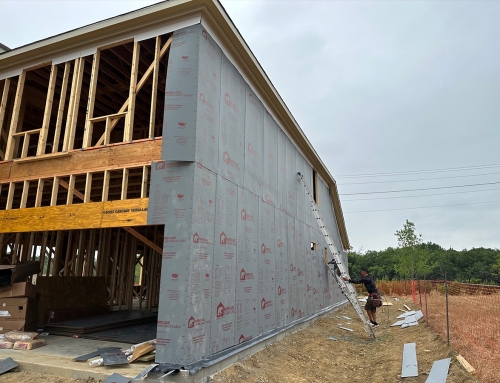Barricade® Building Wrap is a high-performance air barrier that supplies continuous control of airflow over the entire building enclosure and can withstand damage during and after medical building construction.
A high-performance air barrier system is a vital component of medical building construction for achieving a healthy, durable, and energy-efficient structure with a tight building envelope. A high-performance air barrier system will also contribute towards stopping thermal bridging, increasing the effective R-value, and eliminating condensation within the wall systems of a medical building.
Essential elements of a high-performance air barrier system for medical buildings include code compliance, proper permeability, and the ability to control air and moisture infiltration.
A High-Performance Air Barrier System for Medical Building Construction Achieves Building and Energy Code Standards
The 2018 International Energy Conservation Code® (IECC®) Building Energy Codes and Standards determine minimum efficiency requirements for medical buildings, which assures reduced energy use and emissions over the medical building’s lifetime.
The Permeability of a High-Performance Air Barrier Controls Indoor Air Quality and Maintains the Durability of a Medical Building
Moisture vapor permeability of a high-performance air barrier is essential to ensuring that the water that invades a wall system can escape. Water can get inside a wall assembly when rain leaks through the building envelope, through convection and conduction, and from the inside of the structure if the HVAC system does not effectively remove the moisture. Trapped moisture in a wall system is a problem because it can lead to mold, which is both unhealthy to the occupants of a medical building and can damage the integrity of the structure.
A High-Performance Air Barrier Minimizes Moisture Intrusion Due to Air Infiltration
A high-performing air barrier system for medical construction resists air infiltration, and the moisture associated with it, into the wall assembly. Moisture can enter a wall assembly by thermal convection. Thermal convection occurs when warm air (which contains moisture) outside the wall assembly, is pulled towards the cooler air inside the wall assembly.
Stopping air-transported moisture from getting to the interior of a wall assembly is crucial because when the warm vapor touches the cooler interior walls, the vapor turns to liquid by condensation. A high-performance air barrier resists the flow of air and reduces, if not eliminates, moisture intrusion into the wall system by thermal convection.
Stopping Air Infiltration with a Durable Air Barrier
Good durability in a high-performance air barrier is also critical to stopping air infiltration. Good durability resists damage or defects to the air barrier, either during or after installation, which will lessen its air-resistance performance. A high-performance air barrier has the strength to remain intact during and after medical building construction.
A High-Performance Air Barrier Controls Unwanted Heat Gains or Losses
A high-performance air barrier controls unwanted heat gains and losses. Controlling heat flow is essential to a medical building’s energy efficiency and the comfort of the occupants. It is important that an air barrier lessens or restricts heat gains and losses through radiation, conduction, and convection.
- Thermal radiation moves heat from hot areas to cooler areas by electromagnetic waves, which is mainly the sun’s rays. Thermal radiation happens between two spaces in view of each other; they do not require a medium, like water and air, to move through space. All materials emit, reflect, and absorb radiant energy. A material’s ability to emit energy as thermal radiation or to radiate absorbed energy is called its emissivity. A high emissivity substance has low reflectivity and will rapidly absorb energy that hits it.
- Thermal conduction is when warm particles spontaneously move towards and collide with colder molecules. The effective R-value of a building’s wall assembly is its resistance to conduction (the action of hot molecules moving towards colder molecules).
- Thermal convection is heat energy that moves from a warmer spot to a colder space by the flow of fluids (usually gases and liquids). For example, if it is warmer inside a structure than it is outside, the hotter air will move towards the cold air. Reducing, if not eliminating thermal convection is vital for stopping the loss of heat energy inside a medical building.
Why Barricade Building Wrap is an Excellent Choice for a High-Performance Air Barrier for Medical Building Construction
Barricade Building Wrap is a high-performance air barrier that meets current codes and standards. Barricade Building Wrap is also an air- and water-resistant building barrier that stops air infiltration, prevents heat gains and losses, protects air quality, and maintains a medical building’s durability.
- Meets and exceeds the air barrier requirements of the 2018 IECC R402.4.1 and C402.5.1.
- Permeable to vapor and highly air resistance, which ensures a comfortable, healthy, energy-efficient, and durable medical building.
- Barricade Wrap maintains its integrity before and after installation, which ensures the durability of a medical building.
- Can weather 12 months of UV-exposure without damage.
- Has a tear-stop design with superb strength.
- Barricade’s resistance to temperature (AC38 Section 3.3.4) will not crack at low temperatures.
Barricade® Wrap provides the vital elements of a high-performance air barrier for medical building construction: code compliance, resistance to air and moisture infiltration, control over heat loss and gains, and assurance of a healthy and durable structure. Barricade house wraps supply continuous control of airflow over the entire building enclosure and withstands damage during and after construction.







